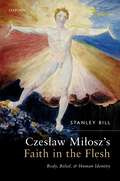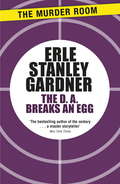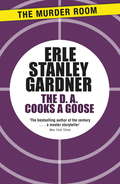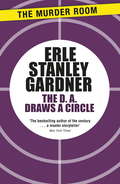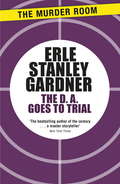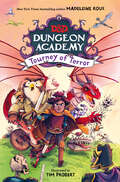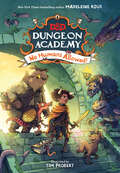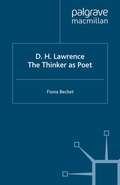- Table View
- List View
The Czech Manuscripts: Forgery, Translation, and National Myth (NIU Series in Slavic, East European, and Eurasian Studies)
by David L. CooperThe Czech Manuscripts is dedicated to one of the most important literary forgeries on the model of Macpherson's Ossianic poetry. The Queen's Court and Green Mountain Manuscripts, discovered in 1817 and 1818, went on to play an outsized role in the Czech National Revival, functioning as founding texts of the national mythology and serving as sacred works in the long period when they were considered genuine. A successful literary forgery tells a lot about what a culture wants and needs at a particular moment. One fascinating aspect of this story is how a successful fake was able to function in an integral way as part of the Czech cultural revival of the nineteenth century, both because it played to expectations and nationalist values and because it met real cultural needs in many ways better than genuine historical literary works and artefacts. Also fascinating is the vainglorious Václav Hanka, a prolific and dedicated forger who was likely the center of the conspiratorial ring that created the manuscripts and who went on as the librarian of the Czech National Museum to alter a number of others. David Cooper analyzes what made the Manuscripts a convincing imitation of their Serbian and Russian models. He looks at how translation shaped their composition and at the benefit ofexamining them as pseudotranslations, and investigates the quasi-religious rituals and commemorative practices that developed around them. The Czech Manuscripts brings the Czech experience into the broader developments of European history.
Czesław Miłosz's Faith in the Flesh: Body, Belief, and Human Identity
by Stanley BillThis book presents Czesław Miłosz's poetic philosophy of the body as an original defense of religious faith, transcendence, and the value of the human individual against what he viewed as dangerous modern forms of materialism. The Polish Nobel laureate saw the reductive "biologization" of human life as a root cause of the historical tragedies he had witnessed under Nazi German and Soviet regimes in twentieth-century Central and Eastern Europe. The book argues that his response was not merely to reconstitute spiritual or ideal forms of human identity, which no longer seemed plausible. Instead, he aimed to revalidate the flesh, elaborating his own non-reductive understandings of the self on the basis of the body's deeper meanings. Within the framework of a hesitant Christian faith, Miłosz's poetry and prose often suggest a paradoxical striving toward transcendence precisely through sensual experience. Yet his perspectives on bodily existence are not exclusively affirmative. The book traces his diverse representations of the body from dualist visions that demonize the flesh through to positive images of the body as the source of religious experience, the self, and his own creative faculty. It also examines the complex relations between "masculine" and "feminine" bodies or forms of subjectivity, as Miłosz represents them. Finally, it elucidates his contention that poetry is the best vehicle for conveying these contradictions, because it also combines "disembodied", symbolic meanings with the sensual meanings of sound and rhythm. For Miłosz, the double nature of poetic meaning reflects the fused duality of the human self.
Czesław Miłosz's Faith in the Flesh: Body, Belief, and Human Identity
by Stanley BillThis book presents Czesław Miłosz's poetic philosophy of the body as an original defense of religious faith, transcendence, and the value of the human individual against what he viewed as dangerous modern forms of materialism. The Polish Nobel laureate saw the reductive "biologization" of human life as a root cause of the historical tragedies he had witnessed under Nazi German and Soviet regimes in twentieth-century Central and Eastern Europe. The book argues that his response was not merely to reconstitute spiritual or ideal forms of human identity, which no longer seemed plausible. Instead, he aimed to revalidate the flesh, elaborating his own non-reductive understandings of the self on the basis of the body's deeper meanings. Within the framework of a hesitant Christian faith, Miłosz's poetry and prose often suggest a paradoxical striving toward transcendence precisely through sensual experience. Yet his perspectives on bodily existence are not exclusively affirmative. The book traces his diverse representations of the body from dualist visions that demonize the flesh through to positive images of the body as the source of religious experience, the self, and his own creative faculty. It also examines the complex relations between "masculine" and "feminine" bodies or forms of subjectivity, as Miłosz represents them. Finally, it elucidates his contention that poetry is the best vehicle for conveying these contradictions, because it also combines "disembodied", symbolic meanings with the sensual meanings of sound and rhythm. For Miłosz, the double nature of poetic meaning reflects the fused duality of the human self.
The D.A. Breaks an Egg (Doug Selby D.A.)
by Erle Stanley GardnerD.A. Doug Selby was in trouble again. An enticing redhead had been murdered; the county newspaper, The Blade, was after his neck; he had an unsolved jewellery theft on his hands and that sly, unscrupulous attorney A.B. Carr was running circles around him.Selby knew that somehow or other all four of his troubles were tied up in one explosive bundle. But how could he open the bundle ... without setting off more murder?
The D.A. Calls it Murder (Doug Selby D.A.)
by Erle Stanley GardnerThe little clergyman had died peacefully in bed in the Madison Hotel. But Douglas Selby, recently elected District Attorney, suspected there was more to this death than meets the eye, and soon knew that something was definitely wrong.So Doug finds himself faced not only with a wily murderer, but with virulence from a hostile press, reluctant witnesses, and a film star unwilling to explain why she was on the spot.
The D.A. Cooks a Goose (Doug Selby D.A.)
by Erle Stanley GardnerA midnight hit-and-run accident on a mountain road ... a tragic fatality ... the discovery of the missing car ... and Doug Selby, District Attorney of Madison City, finds himself not only up against a most involved case but in the hottest spot of his career.Featuring an absorbing cast of supporting characters, including genial Sheriff Rex Brandon, the sly, suave A.B. Carr, a strange couple from New Orleans who should be cooperative but aren't, and Inez Stapleton, Madison City's only woman lawyer, who finds the going tough when she tries to be both friend and foe of Doug Selby.
The D.A. Draws a Circle (Doug Selby D.A.)
by Erle Stanley GardnerThe murdered man had been shot - twice. Either bullet could have caused the death.D.A. Doug Selby had both the bullets and one of the guns. On that gun were the fingerprints of Pete Ribber, a known criminal. The other bullet was from a different - and missing - gun.Which bullet had caused the death? That was the D.A.'s problem. Because there's no law against firing a bullet into a corpse ...
The D.A. Goes to Trial (Doug Selby D.A.)
by Erle Stanley GardnerThe case started with a corpse. Nobody knew who he was. Next, a man named John Burke disappeared. But D.A. Doug Selby could not find his body.Then Mrs Burke swore that the corpse and her missing husband were one and the same man. This should have solved both mysteries. All it did was run the D.A. up two different trees. Sure, the faces of the dead man and John Burke were exactly the same. The only trouble was that their fingerprints were different!Impossible? That's what Doug Selby thought too - until the killer struck again ...
The D.A. Holds a Candle (Doug Selby D.A.)
by Erle Stanley GardnerDouglas Selby, the ambitious young District Attorney of the territory around Madison City, had up before him a young man guilty of embezzling a comparatively small sum of money which he had spent gambling. Selby could have locked him up - and perhaps ruined his life. But he wanted to find the how and the why of this otherwise law-abiding young man's gambling.Selby's investigations led him to a hit-and-run motorcycle accident, to blackmail, and to the doorstep of DeWitt Stapleton, the local big-wig, who ran things in that part of the country by and for himself.
The D.A. Takes a Chance (Doug Selby D.A.)
by Erle Stanley GardnerBlond Eve Dawson came to Hollywood to be a star and didn't make the grade. But as a party girl she was much in demand - until someone shot her during a wild party given for a lot of prominent politicians. Everyone clammed up and pressure was brought to bear - even on popular D.A. Doug Selby. But Selby and Sheriff Brandon wouldn't hush. The next time beautiful Eve turned up she was a corpse with a carving knife deep in her chest. And even that suave old fox A.B. Carr couldn't stop the D.A. from finding out who killed her and why.
D.b. Hayes, Detective (Lipstick Ltd. #2)
by Dani SinclairRISKY BUSINESS So what if my two biggest clients were a known mobster and a ten-year-old kid looking for his cat–business was business. Until Brandon Kirkpatrick walked into my life and made business murder.
The D Case Or The Truth About The Mystery Of Edwin Drood: The Truth About The Mystery Of Edwin Drood
by Fruttero , Carlo And Lucentini , FrancoAt an international literary conference in Rome in the near future, the greatest detectives in history (and literature) gather to solve the mystery of Dickens' unfinished novel THE MYSTERY OF EDWIN DROOD and end up solving the mystery of Dickens' own death. At this crazy conference are Father Brown, Holmes, Maigret, Poirot, Marlowe, Lew Archer and even Nero Wolfe. Dickens' marvelously atmospheric novel is read to them (or imprinted on their brains by a new Japanese technique), chapter by chapter - and for the reader the chapters are interleaved with the story of the goings-on at the conference. Part detective story, part comic academic novel, part science fiction, part playful scholarship, part Dickens, THE D CASE is dazzling, offbeat, hilarious and original. (Translated by Gregory Dowling)
D&D Dungeon Academy 2
by Madeleine RouxWelcome to Dungeon Academy, where monsters and creatures train for the dark world that awaits just beyond the Dungeon walls.
D&D Dungeon Academy No Humans Allowed
by FarshoreWelcome to Dungeon Academy, where monsters and creatures train for the dark world that awaits just beyond the Dungeon walls.
The D.D. Warren Case Files (A Sampler): The Complete Collection of First Chapters
by Lisa GardnerDo you love NYT #1 Bestselling Lisa Gardner's brilliant novels? Have you never read her? Do you want to know more about her series and characters? Undeniably one of Lisa Gardner's greatest characters, D.D. Warren is smart, tough and stubborn to a fault. This exciting and thrilling introduction to the Detective D.D. Warren series features opening chapters from all seven novels in her series, including the latest, FEAR NOTHING - out now in ebook and in paperback on 10th October 2014. Heart-racing suspense and irresistible characters from the bestselling author of TOUCH & GO, CATCH ME, LOVE YOU MORE and many others.
D-Day: Storming Fortress Europe (Under Fire)
by Jack Chambers Erik Hendrix6 June, 1944: a vast armada stands off the coast of Normandy; in the pre-dawn gloom gliders carrying British airborne troops approach their target. The first shots are about to be fired in 'the Great Crusade' to free Europe from Nazi occupation and thousands of troops will fight their way ashore in the teeth of deadly machine-gun and artillery fire from the German defenders. D-Day is about to begin. The Normandy landings are brought alive in this electrifying graphic novel that tells the story of that Longest Day through the eyes of the men who were there. Discover an epic struggle as the Allies sought to overwhelm the German defenders by land, sea and air, who in turn battled desperately to drive the invasion back into the sea. Covering the full range of events from the earliest airborne assault through the struggle on the beaches and the desperate effort to establish a bridgehead inland, D-Day blends an authentic historical narrative with master illustration to reveal the full story of the day that changed the course of World War II.
D-Day: Storming Fortress Europe (Under Fire)
by Jack Chambers Erik Hendrix6 June, 1944: a vast armada stands off the coast of Normandy; in the pre-dawn gloom gliders carrying British airborne troops approach their target. The first shots are about to be fired in 'the Great Crusade' to free Europe from Nazi occupation and thousands of troops will fight their way ashore in the teeth of deadly machine-gun and artillery fire from the German defenders. D-Day is about to begin. The Normandy landings are brought alive in this electrifying graphic novel that tells the story of that Longest Day through the eyes of the men who were there. Discover an epic struggle as the Allies sought to overwhelm the German defenders by land, sea and air, who in turn battled desperately to drive the invasion back into the sea. Covering the full range of events from the earliest airborne assault through the struggle on the beaches and the desperate effort to establish a bridgehead inland, D-Day blends an authentic historical narrative with master illustration to reveal the full story of the day that changed the course of World War II.
D.G. Compton SF Gateway Omnibus: Synthajoy, The Steel Crocodile, Ascendancies (Sf Gateway Omnibuses Ser.)
by D.G. ComptonD.G. Compton is best known for his prescient 1974 novel, THE CONTINUOUS KATHERINE MORTENHOE, which predicted the 21st century's obsessions with media voyeurism and 'reality television'. It was filmed as DEATH WATCH in 1980 by Bertrand Tavernier. This omnibus collects three of his incisive SF novels, ASCENDANCIES, SYNTHAJOY and THE STEEL CROCODILE. ASCENDANCIES: Into a future where a depleted fuel supply had the world spiralling down into grinding poverty and constant war came ... Moondrift. Mysterious white flakes of alien matter that was the perfect fuel - clean, powerful, dependable. But the aliens - or whatever they were - who sent Moondrift seemed to demand a heavy ransom in return...SYNTHAJOY: Would you like to experience first-hand the emotions of a great artist, the sublime peace of a saint, the happiness of a child at Christmas? Try Sensitape. Or perhaps you had something more passionate in mind. Don't be shy. Ask for Sexitape. And for the true connoisseur, we have the ultimate human experience: a distinguished blend of synthetic ecstasies. The world is not ready for it, but perhaps you are. We call it Synthajoy.THE STEEL CROCODILE: In answer to an unanswerable future, science has created Bohn, the omnipotent computer whose flashing circuits and messianic pronouncements dictate what tomorrow will - or will not - be. But Matthew Oliver is flesh and blood and full of questions - not nearly as certain as the machine he's appointed to serve. And the right hand of science seldom knows what the left hand is doing...
D.H. Lawrence: The Thinker As Poet
by F. BecketD.H. Lawrence: The Thinker as Poet addresses a particular body of language and thought within Lawrence's oeuvre where the metaphorical, the poetic and the philosophical are intricately enmeshed. Lawrence emerges as a writer who pulls metaphor away from its merely rhetorical moorings: his distinctive style is the hallmark of one who thinks not analytically but poetically, about the birth of the self, the body unconscious, complex kinds of otherness and about metaphor itself as a mode of understanding.
D.H. Lawrence (Routledge Guides to Literature)
by Fiona BecketSo many questions surround the key figures in the English literary canon, but most books focus on one aspect of an author's life or work, or limit themselves to a single critical approach. D. H. Lawrence is a comprehensive, user-friendly guide which: * offers basic information on Lawrence's, contexts and works* outlines the major critical issues surrounding his works, from the time they were written to the present* explain the full range of often very different critical views and interpretation* offer guides to further reading in each area discussed. This guidebook has a broad focus but one very clear aim: to equip you with all the knowledge you need to make your own new readings of the work of D. H. Lawrence.
D.H. Lawrence (Routledge Guides to Literature)
by Fiona BecketSo many questions surround the key figures in the English literary canon, but most books focus on one aspect of an author's life or work, or limit themselves to a single critical approach. D. H. Lawrence is a comprehensive, user-friendly guide which: * offers basic information on Lawrence's, contexts and works* outlines the major critical issues surrounding his works, from the time they were written to the present* explain the full range of often very different critical views and interpretation* offer guides to further reading in each area discussed. This guidebook has a broad focus but one very clear aim: to equip you with all the knowledge you need to make your own new readings of the work of D. H. Lawrence.
D. H. Lawrence: Nature, Narrative, Art, Identity
by J. BeerA full account of Lawrence, ranging from his talent as a young writer to the continuing genius of his later work, and concentrating on his exceptionally acute powers of observation, both human and natural.
D. H. Lawrence: Sons And Lovers:essays On Japanese History And Politics (pdf) (Author Chronologies Series)
by R. P. DraperD.H. Lawrence: The Utopian Vision
by Eugene GoodheartThe dominant view of D.H. Lawrence's work has long been that of F. R. Leavis, who confined Lawrence within an exclusively ethical and artistic tradition. In D.H. Lawrence: The Utopian Vision, Eugene Goodheart widens the context in which Lawrence should be understood to include European as well as English writers - Blake, Nietzsche, Rilke, and Freud among others. Goodheart shows that the characteristic impulse of Lawrence's principal discovery was the bodily or physical life that he believed man had once possessed in his pre-civilized past and must now fully recover if future civilized life is possible. Goodheart's argument fully engages the paradoxes of Lawrence's writing. He is at once the last great representative of the moral tradition of the English novel and of the English Protestant imagination and a novelist without precedent, a diabolist in the service of the dark gods. He rejects the claims of society, while simultaneously lamenting the thwarting of the societal instinct. The oppositions and paradoxes in the work are the expression of a single, not always coherent, revolutionary imagination. D.H. Lawrence: The Utopian Vision provides a rigorous and critical analysis of the ideological character of Lawrence's novels and essays, in particular the effect of his utopianism on his views of nature, myth, and religious experience, while responding to his aesthetic achievement. Goodheart's Lawrence is a prophetic artist whose vision is at once inspiring and dangerous. In the new introduction to the book, Goodheart reflects upon the vicissitudes of Lawrence's reputation since the sixties when the book first appeared and his relevance to the concerns of our own time.
D.H. Lawrence: The Utopian Vision
by Eugene GoodheartThe dominant view of D.H. Lawrence's work has long been that of F. R. Leavis, who confined Lawrence within an exclusively ethical and artistic tradition. In D.H. Lawrence: The Utopian Vision, Eugene Goodheart widens the context in which Lawrence should be understood to include European as well as English writers - Blake, Nietzsche, Rilke, and Freud among others. Goodheart shows that the characteristic impulse of Lawrence's principal discovery was the bodily or physical life that he believed man had once possessed in his pre-civilized past and must now fully recover if future civilized life is possible. Goodheart's argument fully engages the paradoxes of Lawrence's writing. He is at once the last great representative of the moral tradition of the English novel and of the English Protestant imagination and a novelist without precedent, a diabolist in the service of the dark gods. He rejects the claims of society, while simultaneously lamenting the thwarting of the societal instinct. The oppositions and paradoxes in the work are the expression of a single, not always coherent, revolutionary imagination. D.H. Lawrence: The Utopian Vision provides a rigorous and critical analysis of the ideological character of Lawrence's novels and essays, in particular the effect of his utopianism on his views of nature, myth, and religious experience, while responding to his aesthetic achievement. Goodheart's Lawrence is a prophetic artist whose vision is at once inspiring and dangerous. In the new introduction to the book, Goodheart reflects upon the vicissitudes of Lawrence's reputation since the sixties when the book first appeared and his relevance to the concerns of our own time.

